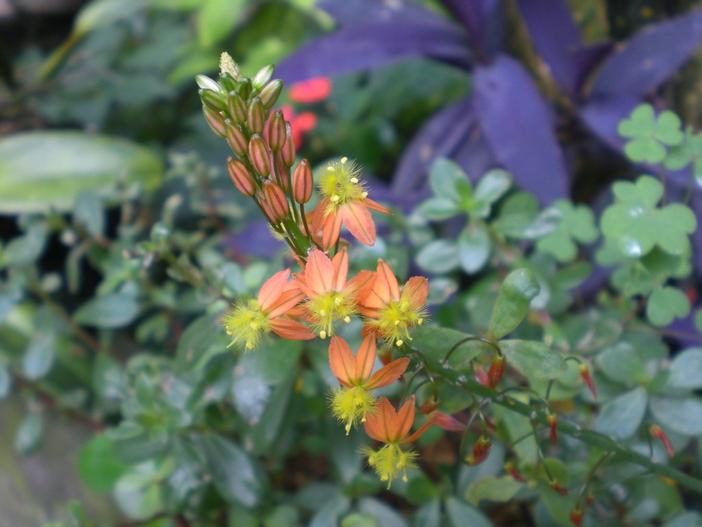Orange Bulbine
(Bulbine frutescens)
Orange Bulbine (Bulbine frutescens)
/
/

salles1
CC BY 2.0
Image By:
salles1
Recorded By:
Copyright:
CC BY 2.0
Copyright Notice:
Photo by: salles1 | License Type: CC BY 2.0 | License URL: https://creativecommons.org/licenses/by/2.0/ | Uploader: salles1 | Publisher: Flickr















































































Estimated Native Range
Summary
Bulbine frutescens, commonly known as Orange Bulbine, is an evergreen succulent plant native to rocky grasslands and open plains in Southern Africa, particularly South Africa. It typically forms clumps reaching 12-18 inches (30-45 cm) in height and spreading 18-24 inches (45-60 cm) wide. The plant has fleshy, grey-green leaves that are long, narrow, and aloe-like, contributing to its attractive, tufted appearance. Throughout the year, with peaks in spring and autumn, Orange Bulbine produces star-shaped flowers in shades of bright orange, yellow, or occasionally white, atop slender, 12-inch (30 cm) stalks. The flowers are showy and attract pollinators such as bees and butterflies.
Orange Bulbine is valued for its drought tolerance, ease of maintenance, and ability to thrive in challenging conditions. It is often used in rock gardens, as a ground cover, or in containers where its succulent leaves and vibrant flowers add texture and color. This plant prefers well-drained soil, tolerates poor soils, and requires minimal water once established, making it an excellent choice for water-wise gardens. While it can handle full sun, it also grows well in part shade, especially in hot climates. It is not prone to many diseases but can suffer from rot if overwatered. Orange Bulbine is also known for its medicinal properties, with the sap from the leaves used traditionally to treat skin ailments such as rashes, burns, and itchy skin.CC BY-SA 4.0
Orange Bulbine is valued for its drought tolerance, ease of maintenance, and ability to thrive in challenging conditions. It is often used in rock gardens, as a ground cover, or in containers where its succulent leaves and vibrant flowers add texture and color. This plant prefers well-drained soil, tolerates poor soils, and requires minimal water once established, making it an excellent choice for water-wise gardens. While it can handle full sun, it also grows well in part shade, especially in hot climates. It is not prone to many diseases but can suffer from rot if overwatered. Orange Bulbine is also known for its medicinal properties, with the sap from the leaves used traditionally to treat skin ailments such as rashes, burns, and itchy skin.CC BY-SA 4.0
Plant Description
- Plant Type: Succulent
- Height: 1-2 feet
- Width: 3-4 feet
- Growth Rate: Rapid
- Flower Color: Yellow, Orange
- Flowering Season: Spring, Summer
- Leaf Retention: Evergreen
Growth Requirements
- Sun: Part Shade, Full Sun
- Water: Very Low, Low
- Drainage: Fast
Common Uses
Bee Garden, Bird Garden, Border Plant, Butterfly Garden, Deer Resistant, Drought Tolerant, Fire Resistant, Groundcover, Hummingbird Garden, Low Maintenance, Potted Plant, Rabbit Resistant, Salt Tolerant, Showy Flowers, Street Planting
Natural Habitat
Rocky grasslands and open plains in Southern Africa
Other Names
Common Names: Stalked Bulbine, Burn Jelly Plant, Bulbine, Snake Flower, Cat’s Tail
Scientific Names: , Bulbine frutescens, Bulbine caulescens, Anthericum fruticosum, Anthericum frutescens, Bulbine rostrata, Anthericum incurvum, Anthericum rostratum, Bulbine frutescens var. incurva, Anthericum multiceps
GBIF Accepted Name: Bulbine frutescens (L.) Willd.